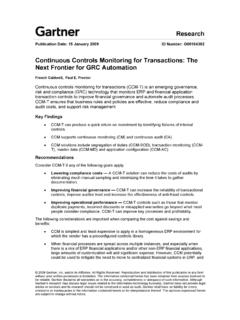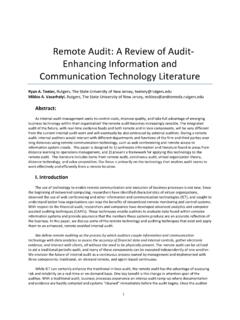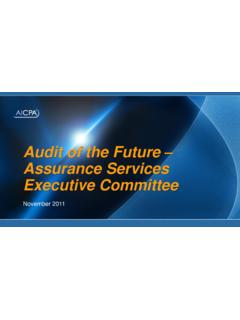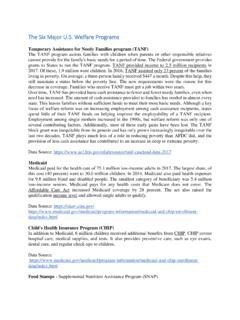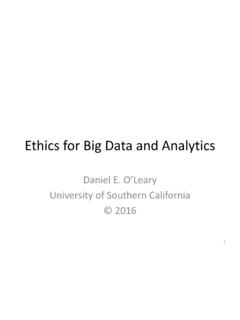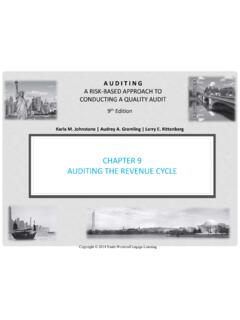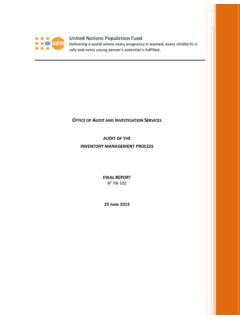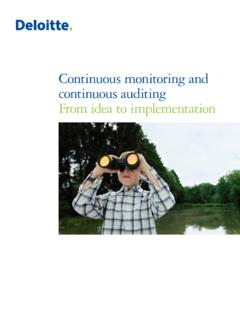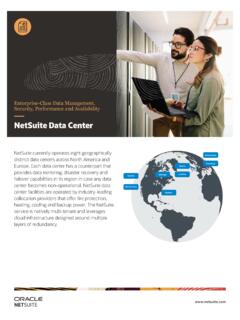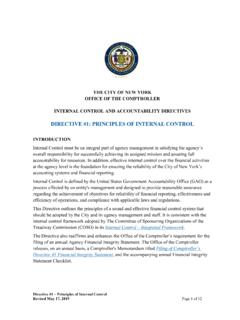Transcription of Six Steps to an Effective Continuous Audit Process
1 1 Six Steps to an Effective Continuous Audit Process Establishing priority areas and determining the Process ' frequency are two of the six Steps that internal auditors and senior managers need to take into consideration before making the switch to Continuous auditing. Carlos Elder de Aquino Chief Auditor, Unibanco Washington Lopes da Silva IT Audit Superintendent, Unibanco Nilton Sigolo Manager, Continuous Auditing, Unibanco Miklos A. Vasarhelyi Professor of Accounting, Business Ethics and Information Systems, Rutgers University The need to improve and accelerate Audit activities has led in part to the increased adoption of Continuous auditing as a vital monitoring tool.
2 Initially recorded at AT&T Corp. by its Bell Laboratories research center during the late 1980s and early 1990s, Continuous Audit efforts are now under way in organizations including Siemens, HCA Inc., Unibanco, the New York Federal Reserve, and IBM. Additionally, legislation such as Section 404 of the Sarbanes-Oxley Act of 2002 and Audit software vendors, including ACL, IDEA, Approva, and Oversight, are molding and giving large momentum to the Continuous Audit field. Consequently, as Continuous auditing continues to grow around the world, internal auditors and senior managers need to understand the necessary actions required to support an Effective Continuous Audit Process , including establishing Audit priority areas and determining the Process ' frequency.
3 BEFORE PITCHING THE IDEA When organizations begin evaluating the adoption of Continuous auditing, three common issues usually arise that if expected can be managed effectively. First, is the confusion among auditors and senior management regarding the differences between Continuous auditing and Continuous monitoring . Second, is the need for auditors to understand the role of Continuous auditing as a meta control ( , a control of controls). And third, is the concern that implementing Continuous auditing will lead to a loss of independence and objectivity as Audit professionals become operationally involved in the Process .
4 While the way in which companies address these challenges will be unique to their organization, the following best practices can help them prepare for these issues. What is Continuous Auditing? 2 According to The Insitute of Internal Auditors' (The IIA) Global Technology Audit Guide (GTAG) Continuous Auditing: Implications for Assurance, monitoring , and Risk Assessment, Continuous auditing is defined as the automatic method used to perform control and risk assessments on a more frequent basis. As the guide states, technology plays a key role in Continuous Audit activities by helping to automate the identification of exceptions or anomalies, analyze patterns within the digits of key numeric fields, review trends, and test controls, among other activities.
5 Other organizations, such as the American Insitute of Certified Public Accountants (AICPA) and the Canadian Institute of Chartered Accountants (AICPA/CICA) have further defined Continuous auditing and provided guidance on the subject. For additional basic information on Continuous auditing, read ITAudit's "Recommendations for an Effective Continuous Audit Process " and "Making the Change to Continuous Auditing." To learn how to implement a Continuous online Audit system, read " Continuous Online Auditing in the Government Sector," which is also available on ITAudit.
6 To learn more about how you can view the entire broadcast, visit The IIA's webcast offerings. Continuous monitoring Vs. Continuous Auditing Typically, Continuous monitoring is a management function to ensure that company policies, procedures, and business processes are operating effectively and addresses management's responsibility to assess the adequacy and effectiveness of internal controls. In addition, Continuous monitoring usually involves the automated testing of all transactions and system activities within a given business Process area against control rules.
7 monitoring may occur on a daily, weekly, or monthly basis based on the nature of the underlying business cycle. Although many of the Continuous monitoring techniques used by management are similar to those performed by internal auditors during Continuous Audit activities, Continuous auditing usually enables auditors to evaluate the adequacy of management's monitoring function and identify and assess risk areas. In addition, clearly communicating the differences between the two will aid in avoiding confusion or resistance to Continuous auditing as a redundant effort.
8 (For more information about the differences between 3continuous monitoring and Continuous auditing, please refer to The IIA's GTAG on Continuous auditing.) Meta control Continuous auditing also tends to be dynamic in nature ( , the auditor can turn Continuous Audit processes on and off based on current system loads by reconfiguring these activities according to the internal Audit plan). Therefore, by monitoring particular configurable items, Continuous auditing provides an additional level of controls and acts as a metal control .
9 For example, a bank can issue an alarm under pre-specified circumstances to the bank manager's supervisor whenever loans reach a pre-authorized level. This activity then increases the level of controls that can be configured, such as by including the choice to have an alarm issued and under which circumstances. Figure 1. Illustration of the Continuous Audit Process ' dynamic nature Independence and Objectivity Finally, because Continuous Audit activities are different from those taking place during a more traditional Audit , Audit principles need to be re-conceptualized.
10 This is because Continuous auditing often places the auditor in the middle of the transaction flow. For instance, at a major US-based electronic brokerage firm that monitors its client's electronic transactions , auditors are notified when a transaction is blocked after certain analytical parameters are met. The auditor then deals directly with the client. As this example illustrates, it is important for internal auditors to make sure that the Continuous Audit Process has a system of checks and balances to maintain the independence and objectivity of their work throughout the Audit .
